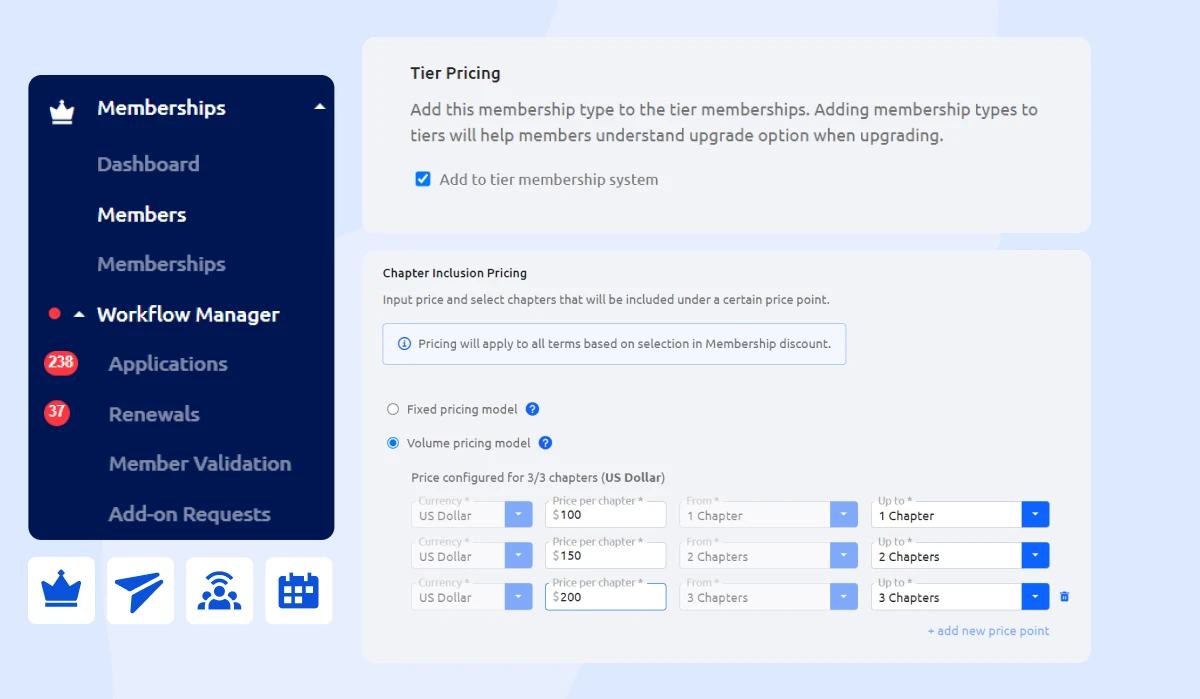
Developing a diverse membership structure is essential for the growth and sustainability of any association. Members' preferences have changed over time, and now, they demand more variety.
Therefore, member-based organizations must provide a range of membership options to address the unique needs and preferences of their target audience, cultivating increased engagement and loyalty.
This blog examines different membership types and explores how they can be utilized to broaden your association's reach and improve the overall member experience. Read on to discover how to create a membership program that drives success.
Key Takeaways
- Diverse membership structures enhance member satisfaction and organizational growth.
- Understanding membership types and levels is crucial for effective strategy development.
- Tailoring benefits and pricing is essential for attracting and retaining members.
- Effective communication is vital for promoting different membership options.
- Glue Up offers a comprehensive platform to manage and optimize diverse membership structures.
Understanding Types of Membership vs. Membership Levels

There are differences between types of memberships and the levels within those memberships. Understanding these distinctions will help you make more informed decisions about which membership option best suits your needs.
Let's explore these terms in depth.
Types of Membership
Types of membership refer to an organization's offering of different categories of memberships, each designed to cater to the diverse needs of its members.
These categories can include:
Individual Memberships
- Tailored for single users
- Personalized services and benefits
Family Memberships
- Benefits for multiple family members
- Discounted rates for groups
Corporate Memberships
- Designed for businesses and their employees
- Networking opportunities and professional development resources
Student Memberships
- Special rates and benefits for students
- Focus on educational benefits and affordability
Membership Levels
Membership levels refer to the different tiers within each type of membership, offering varying degrees of benefits and privileges.
These levels typically include:
Basic Membership
- Essential access to services and facilities
- Minimal cost
Silver Membership
- Additional perks and benefits
- Moderate cost
Gold Membership
- Enhanced benefits and exclusive access
- Higher cost
Platinum Membership
- Premium benefits, including exclusive events and premium content
- Highest cost
Multiple levels are provided to cater to different budgets and preferences, offering members to choose a level that best fits their requirements. Higher levels often come with more comprehensive benefits, providing greater value and a stellar experience.
Understanding these levels helps you identify which tier offers the specific benefits you are looking for and confirms you get the most out of your membership.
Benefits of Offering Different Types of Membership

Offering a variety of membership options is advantageous for associations seeking to expand their reach and improve member satisfaction. Tailoring memberships to diverse member needs can also assist organizations in unlocking numerous benefits.
Let's explore the advantages of implementing a multifaceted membership structure.
Increased Membership Growth
Catering to a wider range of members with diverse needs and interests helps associations expand their membership base and reach new audiences.
Enhanced Engagement
Offering various membership options encourages greater member participation and involvement. Members are more likely to feel valued and connected when they have choices that align with their specific needs.
Stronger Financial Sustainability
A diversified membership structure can lead to a more stable revenue stream. Associations that offer different membership levels and pricing strategies are likely to optimize their income generation.
Greater Industry Influence
A larger and more engaged membership base can amplify an association's voice and impact within the industry, leading to increased visibility and credibility.
Exploring Common Types of Membership

Organizations can offer various common types of memberships, each tailored to meet specific needs and demographics. Understanding these will help you determine which type of membership best suits your requirements.
Full Membership
Full membership refers to the most comprehensive level of membership available, typically offering the widest range of benefits and access to all services and facilities. Members at this level enjoy full voting rights, participation in all events, and the highest level of customer support.
Affiliate Membership
Affiliate membership is often designed for individuals or organizations that want to be associated with the primary organization but do not require full membership benefits. Affiliates may receive limited access to resources, events, and networking opportunities.
Associate Membership
Associate membership is usually a step below full membership, offering many of the same benefits but with some restrictions. Associates may have limited voting rights and access to certain services and events, making this type suitable for those seeking involvement without full commitment.
Honorary Membership
Honorary membership is typically awarded to individuals who have made significant contributions to the organization or the industry. This type of membership is often conferred as a recognition of service and achievement and usually includes all the benefits of full membership without any membership dues.
Government/Institutional Membership
Government or institutional membership is designed for public sector entities or large institutions. The membership often includes benefits tailored to organizational needs, such as access to industry reports, group training sessions, and participation in policy development forums.
Group Membership
Group membership allows multiple individuals to join under a single membership plan, often at a discounted rate. This type is ideal for families, small teams, or community groups who want to share the benefits of membership collectively.
Corporate Membership
Corporate membership is targeted at businesses and corporations, providing benefits such as networking opportunities, professional development resources, and access to industry events. Corporate members often receive multiple individual memberships for their employees and exclusive corporate services.
Retiree Membership
Retiree membership is designed for retired individuals, offering benefits that suit their lifestyle and interests. This type often includes discounted rates, access to social events, and opportunities to stay engaged with the organization post-retirement.
Student Membership
Student membership provides benefits tailored for students, such as educational resources, networking opportunities, and discounted membership fees. The main aim of this membership is to support student's academic and professional growth, and it often includes mentorship programs and internships.
6 Tips for Structuring Membership Types Effectively
Let's discuss practical advice on structuring membership types to maximize value for both the organization and its members. Implementing these tips can help you create a more engaging and beneficial membership program.
Clearly Define Eligibility Criteria
Clearly defining eligibility criteria involves specifying who can join each type of membership. You can include a criteria checklist, including age requirements, professional qualifications, geographical location, and other relevant factors.
Clear criteria help confirm that the right individuals or groups are joining the appropriate membership type, enhancing the overall experience for members.
Tailor Benefits and Value Propositions
As per stats, 67.3% of membership owners are unhappy with engagement levels within their community. This might be because they don't tailor their offerings to meet member needs, resulting in low engagement.
Tailoring benefits and value propositions means customizing the perks and advantages offered to each membership type to meet the members' specific needs and interests, such as exclusive event access, discounts, educational resources, or personalized services, which can significantly increase satisfaction and loyalty.
Set Transparent Pricing
Set transparent pricing and avoid frequent price increases. According to stats, 57.10% of organizations don't intend to increase their prices in the next 12 months. Maintaining consistent pricing increases members' trust in your organization.
Moreover, transparency involves establishing clear and understandable membership fees for each type, detailing what is included at each price point, any additional costs, and the payment methods available. This helps build trust with potential members and makes it easier for them to choose the membership type that best fits their budget and needs.
Promote the Different Options
Promoting the different options means effectively communicating the various membership types and their benefits to potential members. Around 82% of memberships surveyed offer more than one subscription option, marking the importance of providing multiple membership choices.
However, these options can be promoted through marketing campaigns, informational materials, and outreach efforts. Highlighting the unique features of each membership type will let you help prospective members understand their choices and encourage them to join.
Regularly Review and Update
Regularly reviewing and updating membership types involves assessing their effectiveness and making necessary adjustments.
This also includes gathering feedback from members, analyzing usage data, and staying current with industry trends. Regular updates certify that the membership program remains relevant and continues to meet members' evolving needs.
Conclusion: Managing Membership Types Successfully with Glue Up

Implementing a diverse membership structure requires robust membership management software. Tools like Glue Up excel in supporting this strategy. With Glue Up, you can effortlessly create unlimited membership types and tailor specific offers to different member segments.
To effectively manage your membership program, Glue Up membership management software offers a comprehensive suite of features:
- Unlimited Membership Types: Create as many membership categories as needed to cater to diverse audiences.
- Auto-Renewals: Streamline membership renewals for increased revenue and reduced churn.
- Event Management: Plan, promote, and manage member events with ease.
- Financial Management: Gain complete visibility into financial performance and generate insightful reports.
- Recurring Payments: Seamlessly process membership dues and other recurring payments.
- Community Management: Boost member engagement and interaction through online forums and groups.
- Email Campaigns: Execute targeted email campaigns to nurture member relationships.
- CRM: Manage member data, track interactions, and personalize communications.
To discover how Glue Up can revolutionize your membership management, book a demo today.



